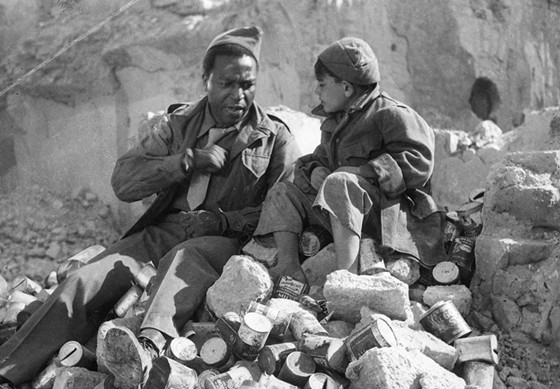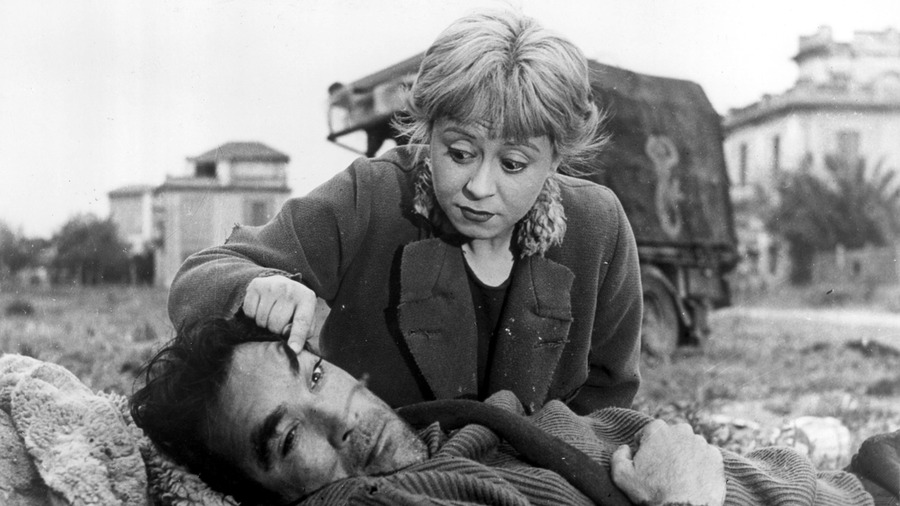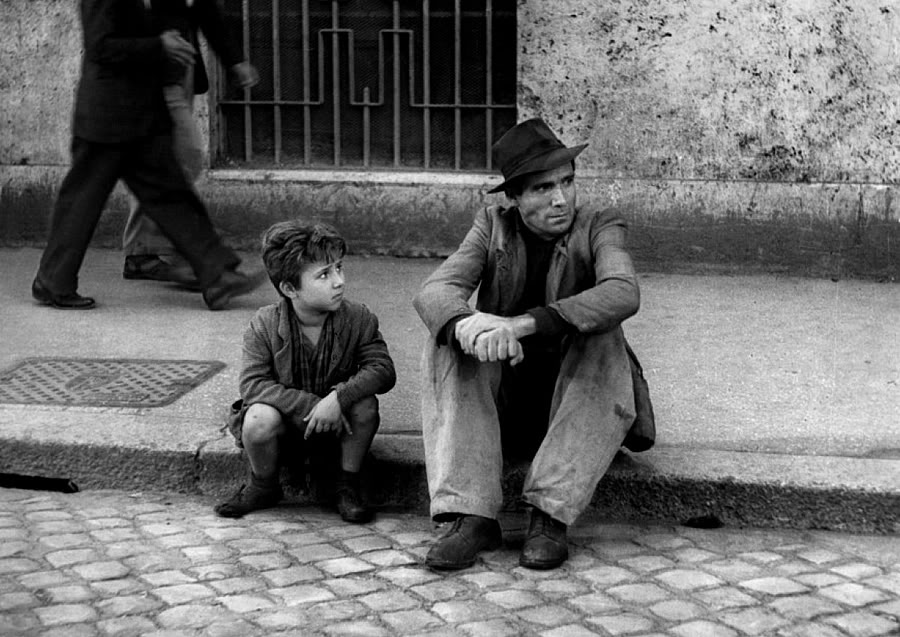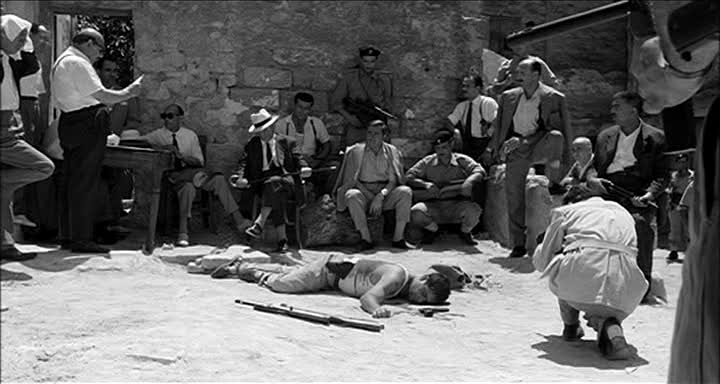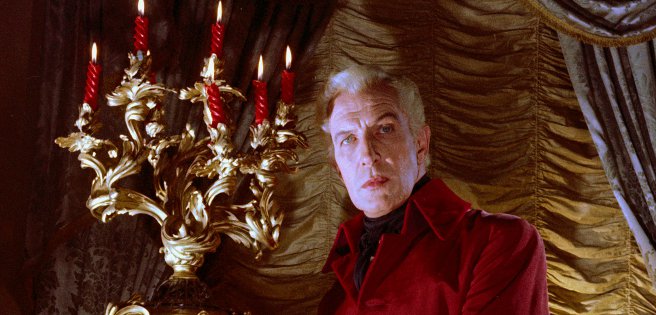6. Paisan (1946, Roberto Rossellini)
An omnibus film covering six episodes of the Italian front in the Second World War, from the invasion of Sicily to the guerrilla fighting in the marshes outside Venice. The film focuses on the distrustful communication between American soldiers and the local people, and the price of liberation.
Rossellini’s own story of three army chaplains staying in a medieval abbey with the cloistered monks who are shocked to discover that one of them is a Jew is exemplary of the film’s theme. Several future stars of Italian cinema contributed to the film, including Federico Fellini (his story of a woman’s search for her lover who has become a legendary resistance leader in the battle for Florence is one of the more nuanced episodes), and Marcello Pagliero.
This is Scorsese’s favorite of Roberto Rossellini’s films. He featured it in his personal documentary My Voyage to Italy. Witnessing his grandparents watching Paisan on TV was a profound moment of American-immigrant experience for him. Their emotional reaction to war in their home country taught him the power of dissolving the barriers between documentary and fiction. And yet, it’s not a sentimental movie at all.
Now one notes that it is rare to feel emotional attachment to Scorsese’s characters. One feels a safe distance from which to observe their struggles. Of course, it is not apathy that is experienced but rather a disinterested interest. As if the inner humanity of the characters is enough to permit us to join them in the squalor of their circumstances.
Now one notes the religious quality of the above statement. Viewing My Voyage To Italy one gets a sense that perhaps Martin Scorsese is a lapse catholic but in cinema he is unabashedly fervent in his belief. He speaks of Paisan and Neorealism in general, saying “Altogether, these movies amounted to a prayer: that the rest of the world look closely at the Italian people and see their essential humanity. That’s why they had to be truthful. There was no choice.”
The quality of that truth encompasses the limits of individual knowledge best exemplified in the Sicilian episode, where a Sicilian woman is murdered by Germans after leading a troop of Americans to safety. The Americans return to discover one of their comrades was killed and they assume it was due to the woman’s betrayal. The dramatic irony was impressive to Scorsese who recounts how his younger self knew that the soldiers would never understand that she sacrificed her life to save theirs, but we, the audience, do.
7. La Strada (1956, Federico Fellini)
Fellini’s road movie about a naïve girl sold to a circus strongman comes early in his transition from Neorealist to a more poetic, personal filmmaking style. Gelsomina (Giulietta Masina) is sold by her mother to Zampano (Anthony Quinn) for 10,000 lire and a few kilos of food. Zampano travels around Italy exhibiting his feats of strength, including breaking a chain wrapped around his chest. He puts Gelsomina to work passing the hat and giving him a drum roll introduction.
Gelsomina comes to believe that they are married, but Zampano treats her with casual cruelty. When they temporarily join a traveling circus, The Fool (Richard Basehart) mocks Zampano and gets Gelosomina to question her loyalty. The antagonism between the strong man and the fool leads to deadly confrontation, and later abandonment.
Of the Neorealist films to be found in this list, La Strada is the closest to following the plot structure of a Scorsese film. Scorsese usually puts his protagonist on a brief rise of fortune, but focuses the majority of the film on the details of the protagonist’s gradual self-destruction and fall from glory. This allows for more dead time where characters are not bound tightly to cause-effect dramatics.
Neorealism savors this banality of action, but Fellini has to have more fun than that. His emphasis in these scenes between the causal plot chain are celebration of life. Weddings, carnivals, the life of town and country rolls out and luxuriate in the experience of living outside literary conventions. There is also the grotesque look of ragged people and scant resources. Through the paucity of these material circumstances, Fellini hints at the brighter aspects of humanity.
His vehicle for this hinting is his wife and leading lady, Giulietta Masina. As Gelsomina, Masina inhabits a child-like curiosity for the world. She plays a type of clown, delicate and quick to joy. There are elements of Charlie Chaplin’s Tramp in her comic routines too.
But the dramatic core of the movie is Anthony Quinn’s Zampano. Scorsese says in his introduction to the Criterion DVD for La Strada that he sensed people like Zampano around him as a child. Men who were angry at the world and angry with themselves. La Strada’s Zampano formed his preference for characters driven to their own destruction. And even the fool has his influence in forming the characters who just can’t help but say one word too many for their own good, like Johnny Boy in Mean Streets or Henry Hill in Joe Pesci memorable scene from Goodfellas.
8. Bicycle Thieves (1948, Vittorio De Sica)
“Ladri Di Biciclette” is the classical single-day drama of a man’s search for his stolen bicycle amid the grotesque variety of human folly in post-war Rome. It is the essential Italian Neorealist film. Desperate to feed his family, the tragic Antonio Ricci stoops to the same crime; but unlike the streetwise hood who stole his bicycle, he is caught. The final shot announces the key refrain of social commentary in Italian Neorealism: before the eyes of our children, what are we becoming?
The powerful simplicity of this movie came out of harsh post-war realities. In My Voyage to Italy Scorsese says that “Beyond everything else, Neorealism came to exist out of a moral and a spiritual necessity.” Bicycle Thieves presented the moral and spiritual dilemma of greed and guilt in a new light for world audiences. Amid a cruel and indifferent world, we see the components of a cinema remarkably similar to Scorsese: a relatable cast of actors (some non-professional), tense action, whirling subjective editing, and dialog that is sometimes humorous and always plebeian.
Antonio Ricci is an Everyman proper to tragedy but he is also a antecedent to many of Scorsese’s protagonists. Cinema favors the hero, who can be generalized as a being with a greater share of efficacy upon his world than the other characters. But rarely do we find a Scorsese protagonist who is so exceptional. Mostly they are commoners with one or two universal attitudes in sharp relief.
One could assume that Jordan Belfort in Wolf of Wall Street is exceptionally good at selling, but mainly he is just greedy enough to say anything. Even in The Last Temptation of Christ, Willem Dafoe’s Jesus of Nazareth is no glowing deity. He’s a man who could use a good night’s rest and is susceptible to temptation until the end.
And while Antonio Ricci is the protagonist of Bicycle Thieves, his antagonist is nowhere to be seen. He might have caught up to the man who stole his bicycle but it is debatable and whatever guilt that individual might have is shared by the neighborhood that protects him and the black market that engenders such thieves. In fact, there is no antagonist, and rarely is there one in a Scorsese film, aside from the institution of law enforcement or organized crime or the shifting conditions of time.
9. Salvatore Giuliano (1962, Francesco Rosi)
Salvatore Giuliano is the corpse in this Neorealistic unspooling of the lives of his outlaws and the political masters behind their deeds. The movie moves across time to tell a tale of Sicily in the 1940s. Director Francesco Rosi used facts from the true crime of Giuliano’s murder and myths from his legacy as Sicily’s most notorious and celebrated criminal to create a damning exposé of Sicilian society, the Mafia, and the government.
Salvatore Giuliano is groundbreaking political filmmaking in that it seeks no scapegoats. Characters have compounded motives of principle and self-interest. A Scorsese protagonist is almost always existing in a morally ambiguous situation. And while they tend to provide their own voiceover to narrate their inner workings like a soliloquy on the stage, it is the reactions and interpretations of the people around them that make their legacies. Scorsese has done many true-life movies, and, excepting his literary adaptations and the kids picture Hugo, his films stay close to the aesthetics of real life drama, true crime, and political films.
In his top 10 list for Criterion Collection, Martin Scorsese summarizes Salvatore Giuliano as a “picture made from the inside, from a profound and lasting love and understanding of Sicily and its people and the treachery and corruption they’ve had to endure.” It’s about his people. That proprietary feeling extends to much of his work about the America and Americans he grew up with or has encountered over the years.
One could argue that the main character of Gangs of New York is New York itself. He spent a real fortune recreating his city in a former manifestation. The growing pains dramatized by the gang violence was another picture made from the inside, from a profound and lasting love and understanding of New York and its people and the treachery and corruption they have endured. Clearly, when Scorsese feels solidarity with a people and a place, he feels it in total.
10. The Fall of the House of Usher (1960, Roger Corman)
Vincent Price plays Roderick Usher in this campy adaptation of Edgar Allan Poe’s gothic short story. Philip Winthrop (Mark Damon) conspires with his fiancée Madeline Usher (Myrna Fahey)to flee the House of Usher, a spooky mansion surrounded by swamps. Roderick tells Philip that the Usher bloodline is cursed with madness, and so he cannot allow his sister Madeline to marry and risk continuing the suffering of future Ushers.
The argument ends when Madeline suddenly dies and is entombed in the family crypt beneath the house. After the ceremony Philip learns that Madeline might have been buried alive, and her brother did it knowingly. He finds the coffin empty and pursues his fiancée, now completely insane, who attacks her brother and begins a fire that burns the house to the ground.
Scorsese was a fan of Corman’s Gothic spook fest The Fall Of The House Of Usher as a horror-loving 18 year-old, so when the King of the B’s offered him his first directorial break with a small-budget gangster movie, Scorsese leapt at the chance. The result was Boxcar Bertha (1972) and while it is hardly a work of staggering genius, it does give proof to Scorsese’s claim that “[t]he best post-graduate training you could have in America at that time was to work for Roger Corman.”
His favorite story about Corman’s generosity with creative control of Boxcar Bertha is that he was allowed to rewrite the script as long as there was nudity every 15 minutes. Corman claims that was Scorsese’s interpretation of the production company’s expectations rather than a true retelling of his directive.
Beyond the biographical tie-in, The Fall of the House of Usher was included in this list because it represents features of Scorsese’s filmography that would be soft-pedaled otherwise. Scorsese makes masterful movies like the examples above, but he also makes movies that are incredibly violent, profane, and hyperbolic. There is a vein of exploitation cinema that is not present in the classier titles listed above.
Wolf of Wall Street is almost cartoonishly exaggerated in its substance abuse, slapstick humor, profanity, and sexual misdeeds. The Departed, Casino, Goodfellas, Taxi Driver, Mean Streets. Everything he has made got the highest restrictive rating for mass audiences except for Hugo, Kundun, and The Aviator. Audiences love it.
In terms of directing actors, he is no Elia Kazan extolling Method acting. DeNiro’s Johnny Boy explodes with spasmodic energy. In Goodfellas, Joe Pesci shoots a young man who he feels has slighted him and cattily denies he has done anything wrong. Leonardo DiCaprio in Wolf of Wall Street reaches theatrical extremes hitherto untouched since playing a campy Romeo in Baz Luhrmann’s Romeo and Juliet.
“When I was growing up, I don’t remember being told that America was created so that everyone could get rich. I remember being told it was about opportunity and the pursuit of happiness. Not happiness itself, but the pursuit.” While Italian Neorealism is the most influential film movement in the work of Martin Scorsese, the most important myth is The American Dream. For as broad as his film knowledge reaches, the ground from which he addresses his audiences is the American expectation for life to continually get better and better.
Ever since he first saw the dark underbelly of this drive for “more, more, more” in 1957’s The Sweet Smell of Success, Martin Scorsese has been fascinated by the brutal means employed to achieve this bright vision of the future. He has taken pains to find the expression of this darkly insistant urge towards a better world in the times in which it is lived; be it 1970s New York or 1990s Las Vegas. Whether it be the pursuit of riches or the pursuit of purity, Martin Scorsese has illuminated some dark places along the road.
